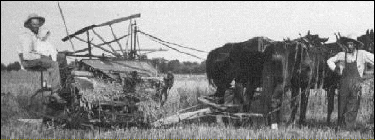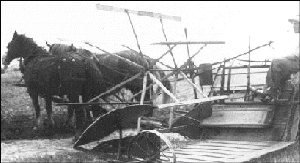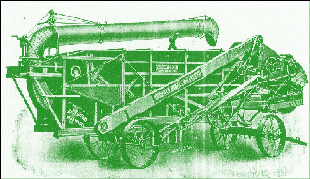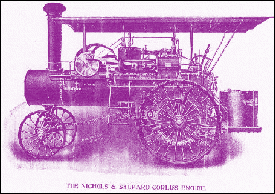A threshing rig: water wagon, steam engine,
power belt, sheave wagons,
separator, bagged grain wagon including plenty of horse and man power.

June. Shelby County farmers
are looking forward to the coming wheat harvest. But, it will be a solitary affair.
Sitting alone in air-conditioned cabs atop their huge harvesters, today’s farmers
experience a far different harvest from the threshing days that brought neighbors together
for hard work, good talk, and food that fueled their bodies and created the legends of the
"thrashin" meals. Memories by long-time Swanders-area farmers Bob Harshbarger
and Russ Sayre follow this account of threshing days printed by an 1893 Sidney newspaper.
100 Years Ago: From the flail and the treadmill to the
modern steam ‘thrashing’ machine, I.D. Hubbard tells the story of separating
grain from the husks. Following are excerpts from his article in the Sept. 22, 1893,
edition of the Shelby County Democrat: Maybe you are not a greenhorn in the
matter of "thrashin." Maybe you can remember, if you were born in the country
and your first birthday was long enough ago, how your father and your grandfather used to
get up long before daylight in the cold winter time, and after eating breakfast by candle light go out to the barn and pound
the grain out all day with flails.
Deacon A... used to have his grain trod out by horses and it was lots of fun to go down
there and help Jim A... drive the horses. Jim didn’t like to do it, but with him it
was work, and he had to keep at it all day... he owns a "separator" and a steam
engine to run it, and he does the "thrashin" for all his neighbors every fall.
While you were yet a small boy the life of the flail and the treading out methods of
thrashing came to an end, and their place was taken by wonderful machines... in one day
three or four men and a team of horses working in a treadmill could thrash out as many
bushels of oats or wheat as your father and grandfather could thrash with flails in weeks
of strenuous pounding.
If it was fun to watch Jim A... drive the horses when the grain was trodden out, it was
joy unalloyed to see the new thrashing machine do its work. A man stood on the floor at
one end and poked the bundles of grain into the mouth of the contrivance, and at the other
end came out the straw, while the grain ran in a little stream into a measure or a bag at
the side. How it was done you couldn’t understand, but you never got tired watching
it, and you used to follow the machine to the neighboring farms.
First step to threshing. Farmers on the
Charlie Enders place east of Pemberton used
a binder to cut the wheat
and create sheaves. They then assembled about 12 sheaves
into a shock. Shocks were later hauled by
wagon
to the separator machine for threshing.
Photo courtesy of Barbara Adams.

But the first small thrashing machines that were run by
treadmill were as nothing by the side of the splendid great "separators" that
took their places. It took more men to operate these machines, and the force was furnished
by horses hitched in teams to the ends of the long sweeps of a "horsepower" that
was set up outside the barn.
When everything was ready, the driver used to get upon the platform in the middle of
the power, and cracking his long whip start the horses on an interminable journey round
and round... in a small circle described by the ends of the revolving sweeps. You used to
think that if when you were a man you could stand up on the platform of a horsepower and
crack your whip and get $1.50 a day for doing it you would have not lived for naught.
There was another man who used to inspire you with admiration, and he was the feeder
who stood on a platform and shoved the grain into the cylinder all day long. He was a man
of nerve and skill, and he got bigger pay than any one else who went with the machine. His
work was hardest, too, and it was possessed of an element of danger that made you shudder
when you thought about it, for while he stood there mid noise and dust and turmoil
imperturbable as a sphinx, he might at any moment, if he carelessly let his hand go too
far toward the swiftly whirling wicked teeth of the cylinder, lose that hand or perhaps an
entire arm.
You will not soon forget the horrible accident that happened to Sam L..., tall,
straight, and blue eyed—Jim A...’s older sister’s "intended." He
was a master hand at feedin’, but one day he turned to speak to the man at his right,
who was "cuttin bands," and his left hand was drawn in. It was but a
moment’s lapse, but it cost Sam his hand and most of his arm, and it was thought for
days and days that he would die from shock and loss of blood. Jim’s sister jilted
him, too, when he got well. She didn’t think she could afford to marry a man with
only one hand, and he went away, out of the...neighborhood.
"When the thrashers come" was always a great day on the valley farms. There
were ten or a dozen of them all told. Three or four "went with the machine" from
farm to farm. The rest were farmers and their hired men, who... helped one another out.
The women folks used to dread "thrashin time," for it meant hard work in the kitchen.
A dozen tired, hungry men can eat a great
many doughnuts and a power o’ pies, to say nothing of the boiled potatoes and pork
and bread. The men who went with the machine assumed a sort of professional superiority
over the rest and were freely accorded the respect which they demanded. No one else was
really a "thrasher," and no one else could tell quite such good stories in the
evening or during the "noonin" after dinner. Besides, they were animated
newspapers, carrying the gossip from farm to farm, and as such were highly regarded by all
the women.
Some years after you had seen the first horsepower and its circling horses
you began to hear about portable "steam ingines" that were to be used to furnish
the power to run the separator. You had never thought of a steam engine as being on any of
the valley farms. Steam engines belonged to the town, not the country, and were apt to
burst, or the fire would cause a conflagration. Everybody protested, but some one bought
one, and the entire valley turned out to see it work. It was so successful that
horsepowers were relegated to a dead past with greater suddenness even than had been the
flail and in a couple of seasons every one was used to seeing the smoke and hearing the
steady puff of the steam thrasher.
The late Bob
Harshbarger (1910-1990), writing a history of the Swanders area in 1987, allowed that the
"modern harvest...was the first wedge to separate farmers as groups into
individuals." Following is his recollection titled "Threshing Rings."
The families we exchanged with, there were no hard and fast "territory,"
except next door "butchering neighbors" who people all down through the years
threshed to-gether, and perhaps on the outer fringe of that. From there on out the
territory would overlap other rings and would be jagged from year to year. These outer
boundries was a good way to get acquainted with people who lived in the community, but you
never really run on to.
Threshing was a very important work-social event, more than most of us realized at the
time. 'Course there were some negative aspects about it, 'cause when you threshed you
opened your place up for God and everybody to see. Sometimes there'd be, golly did you
ever see such a mess? But that didn't go on too much, by and large it was good for
neighbors to get to-gether, exchange bits of useful information, visit, and sure some
gossip, see the innerworkings of other farmers livestock enterprise, crops, be in their
home, get to know their family. Looking back from this point in my life it was a sad day
when the old threshing rings gave way to modern harvest. I would say it was the first
wedge to separate farmers as groups into individuals, and every one of us has suffered the
more from the loss of it.
When I was a little kid there probably wasn't anything that gave me so big a charge as
a threshing machine. I thought they were just so wonderful. To me doing the threshing of
the grain itself was just a byproduct of their fascination. I remember Charlie Pfaadt
saying he "was glad to see it come and glad to see it go." I thought "oh my
gosh, wish it could stay at our house forever."

Bob
Harshbarger ran his binder behind a team in the 1930s. Binders of similar design were
advertised by Fristoe,
Stuart & Company in Sidney newspapers in the 1890s. Photo
courtesy of the Harshbarger family.
One time the
"machine" was at Losch's and was to come to our place next. Why I climbed up on
the wind pump tower every little bit to see if they were done and would be leaving for our
place. After all that anxiety and it did head our way I'd be out at the road
"watching." 'Course soon as it made the turn at the cross road I was hyped up
like you wouldn't believe. Then a few moments later I could hear the crunch of the gravel
from those big broad steel wheels.
A threshing crew
consisted of at least three men, sometimes four. The owner of the rig was generally the
boss, engine man, overall supervisor, quite a "looked up to" individual in the
community. Next was the separator man, he'd be second in command. Then the "water
boy." A fourth member usually some lad "run-and-fetch-it"...
"gopher," officially he was called the blower boy. A job he shared with the
separator man. Most of the straw from threshing was stacked out side, and if there were a
lot of straw and the farmer wanted it all in one big stack, it took a lot of doing to get
that. The blower pipe on a threshing machine was we'll say fourteen feet long, then it
could be telescoped out perhaps twenty...twenty two feet.
There was a mechanism on the machine that could be engaged
to move it from side to side, also up and down. Then out to the end of the pipe was a hood
affair that could be regulated with a rope to cause the straw to go straight out, off to
one side or the other, down, or even back toward the machine a little. The blower on a
grain separator kicked out a powerful blast of air. I know it had to take more energy to
run it than the threshing mechanism itself. A conscientious blower boy earned his money.
Some farmers liked to "work" their stacks, but a good man on the blower could
make a better one without.
Now the water boy, no he wasn't some guy to keep everybody
supplied with drinking water. A steam engine used a lot of water, barrels and barrels of
it. A "rig" also consisted of a water wagon, a tank on wheels, offhand I'd say
held fifteen barrels. By today’s standards he earned his money too. A water wagon was
equipped with a big hand operated suction pump mounted clear up on top. The favorite place
to get water was where a road crossed an open ditch. He'd park his horse(s) and wagon on
the bridge, throw a long suction hose down to the water in the ditch, and start pumpin.
With the pump being a good seven feet up from the bridge floor, and the water at least
five feet below meant he had to lift some fifteen barrels of water at least twelve feet
high, and on the double. The engine man might even be giving the
"get-the-hell-back-here" tootin' on the whistle.
The grain
separator, standing stationary and powered by a steam engine, separated the
grain from the
straw, a function performed today by the grain combine.

That whistle tootin' went on for
a variety of things, some times two or three young spriggs would contest to see who could
put on the most shocks. There we'd be, they'd run out of grain up at the machine, and out
in the field there'd be maybe three big loads and still forking on more. The poor guy that
did go up first caught a round of hell.
Just one more item I want to mention about this
threshing thing, then gotta knock. It was customary for the farmer to furnish the coal for
the steam engine. Occasionally you'd hear some griping about the amount it used. The cost
couldn't have been all that much. Farmers today would be delighted beyond expression if
they could even border on matching operating costs back in the old threshing days.
Russell Sayre, 89,
began farming near Swanders in the early 1930’s. This recent interview with Sayre
recalls the hard work and big meals that he and his neighbors shared until the 1940s. Then
the combine. "Farmers said it wouldn’t work," Sayre said. "But, it did
work and changed a whole way of farming and life."
I can remember threshing days back when I was 4 or 5 years old (about 1913). My Dad
(Frank Sayre), Uncle Fred Russell, and Uncle John Blake owned the Sidney Grain &
Milling Company (located across from current police station). Dad would load up the
Overland with several hundred cotton bags and take them out to the farmer who was
threshing that day. Each bag held 2 1/2 bushels. That’s how they brought the grain to
the elevator for sale.
When I started farming in Franklin Township, we had a large threshing ring, went clear
west on the Swanders road and around to Bud Harmon’s and included Meranda road. I
would say maybe 15 farms, but a lot of those farmers had hired hands, so we might have 35
men working altogether when you count the fellows who owned the threshing rigs. Lenharts
threshed for us and they owned the equipment. Orville was the boss thresher and took care
of the separator. Arly ran the steam engine, and Snapper ran the water wagon.

The steam
engine powered the grain separator with a belt running from a power wheel.
This
illustration came from a 1903 advertising brochure.
I remember one year Bud Harmon had 10 acres
of oats. Martin Hickerson was a heck of a good farm hand. Martin and I had just unloaded
our wagons into the thresher when the separator broke down. There were six other teams all
loaded up and couldn’t unload. Martin was a good loader and I was a good loader and
we put those 10 acres on our two wagons and the boys said they had never seen such loads.
I
had that team of black Percherons and they were the perfect team. Dolly and Bill. And
Martin had a pair of Belgians (roan or chestnut draft horses) and we had those wagons
piled so heavy that the teams could pull them only about 10 feet and they had to stop and
rest. Those steel wheels would sink in the ground.
But those threshing meals were really something. All the women tried to see who could
put on the biggest meal. They would go around to where the threshing was and help out that
woman. You’d have ham and beef, pies, always two long tables of men, sometimes three.
There would be 35 or more men to feed and you had to have a lot of food for them.
You would have a big tub of water in the back yard for the men to wash up. Everybody
used the same water. I’ll never forget. This was when I was a boy in Pemberton. Oh,
what was that guy’s name lived out there near us? They didn’t change the dinner
water for supper and it was cold and dirty. One old man said, "I don’t believe
I’m going to wash" and I mean that was dirty work threshing.
The grain combine, introduced in this area in the early 1940s, really changed the way
small grains were harvested and in the way farmers cooperated. Threshing rings which had
brought the community together for hard work and heavy eating phased away. A single
machine combined in one operation all the cutting, binding, and grain separating; in fact,
"combine" was an entirely appropriate name because it combined the jobs of the
many into the job of a single farmer. He could now harvest alone, if need be.
You should have heard the farmers talk about the combine then. They said it will never
work because you can’t get the grain dry. Combines would not work in this part of the
country, maybe out west, but not here. Then a few farmers got them and they worked so well
that pretty soon everybody got them. I returned to farming in 1947 and bought my first
combine in 1948, a 36-inch McCormick-Deering combine that I bought from W.E. Bumgardner in
Sidney. It was just a little thing.
|

